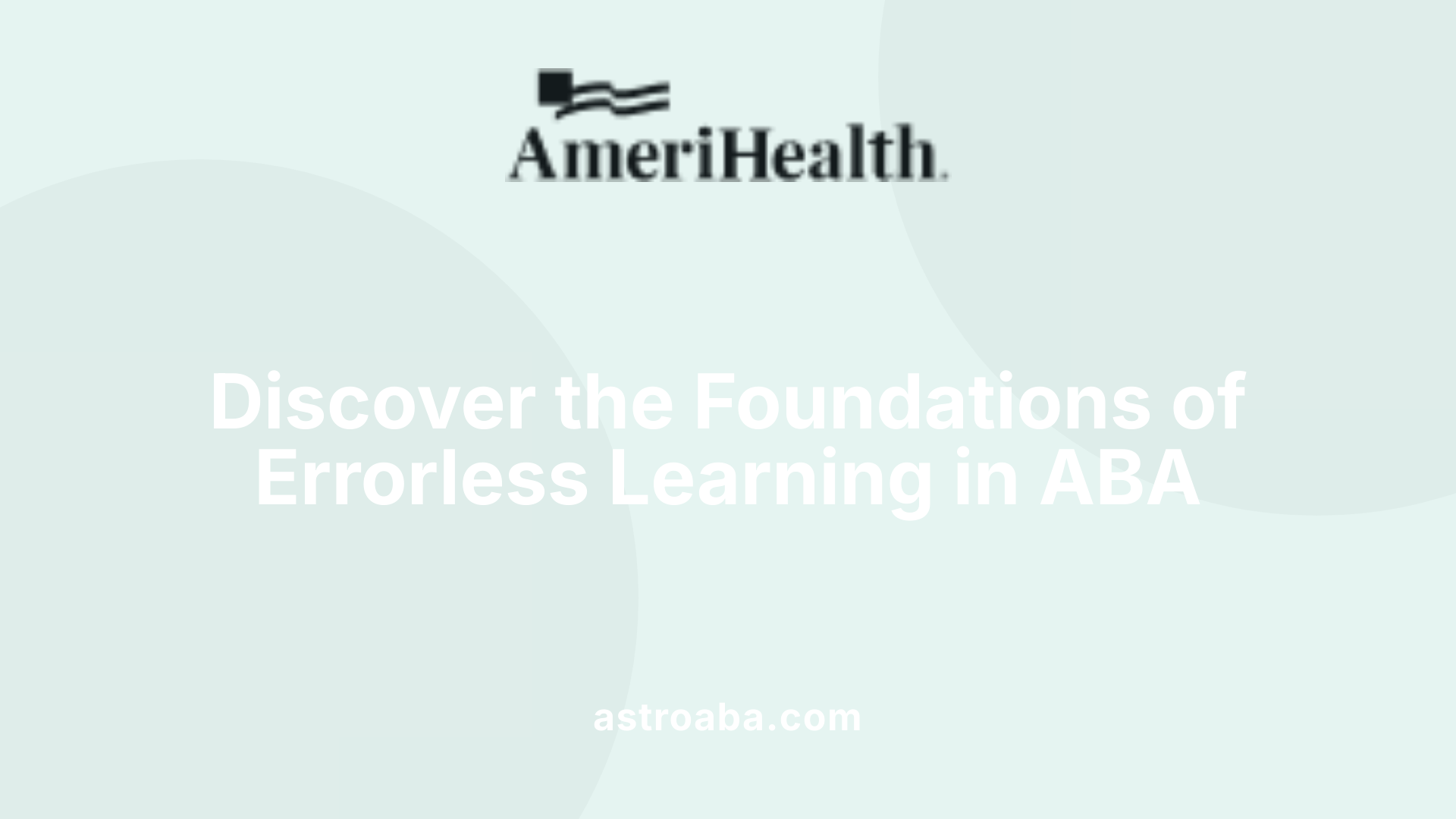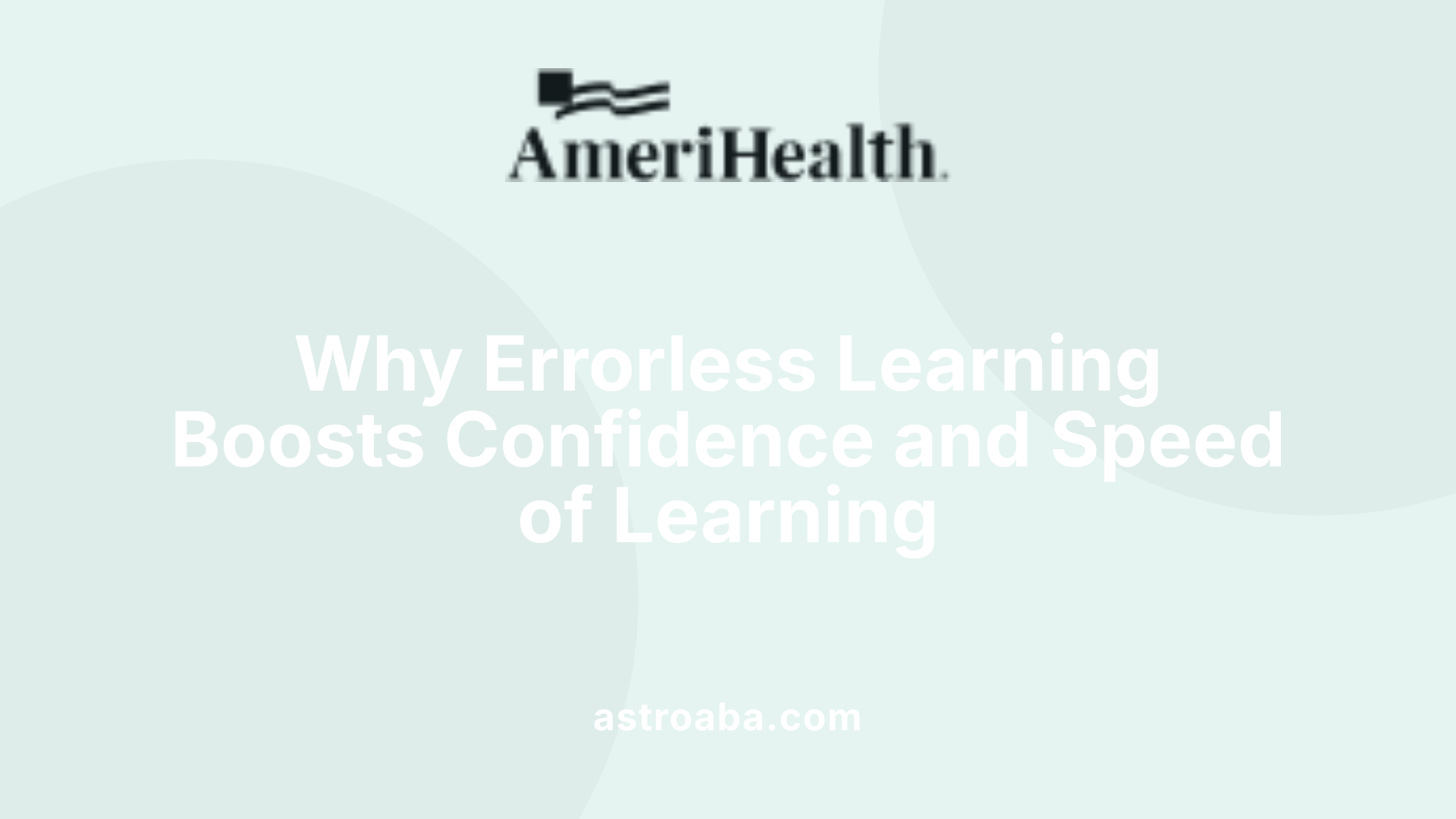What is Errorless Learning in ABA Therapy?
Enhancing Learning Outcomes with Strategic Techniques

Understanding the Foundation of Errorless Learning in ABA
Errorless Learning (EL) is a targeted teaching method within Applied Behavior Analysis (ABA) designed to maximize skill acquisition while minimizing errors and associated negative emotional responses. This approach ensures learners respond correctly from the outset, creating a positive learning environment that is especially beneficial for individuals with autism or other developmental disabilities. In this article, we explore the core principles, implementation strategies, and empirical support behind Errorless Learning, providing a comprehensive understanding of its role in effective behavioral interventions.
Defining Errorless Learning and Its Core Principles

What is Errorless Learning in ABA Therapy?
Errorless Learning (EL) is a teaching approach commonly used within Applied Behavior Analysis (ABA). Its primary goal is to help learners acquire new skills with minimal chances for mistakes. This method involves providing immediate, carefully planned prompts—such as physical guidance, verbal cues, visual aids, or gestures—to guide learners toward the correct response.
The process starts with breaking down complex skills into small, achievable steps. Teachers or therapists then use prompts at each step, reinforcing correct responses with praise or tangible rewards. Over time, these prompts are systematically decreased or faded, encouraging the learner to respond independently.
One of the essential features of EL is its structured approach to prompt fading, which might include techniques like most-to-least prompting, graduated guidance, or time delay prompting. These techniques gradually reduce assistance, fostering independence.
This method is especially beneficial for individuals with autism or other developmental disabilities. It helps prevent the frustration associated with making errors, increasing confidence and motivation. It also promotes faster learning, better generalization of skills, and reduces problematic behaviors that can arise from errors or failure.
Overall, Errorless Learning creates a positive, success-focused learning environment. It emphasizes success rather than correction, boosting self-esteem, and making the acquisition of new skills more efficient and less stressful for the learner. It is particularly effective during initial teaching phases or when introducing new skills where errors could compromise learning or increase anxiety.
Techniques and Strategies in Errorless Learning

What are common techniques used in Errorless Learning?
Errorless learning employs various techniques to ensure learners respond correctly and build confidence. Central to this approach is providing immediate prompts — which can be physical, verbal, visual, or gestural — right after an instruction. For example, a therapist may guide a child's hand to imitate a gesture or provide a verbal cue to facilitate the correct response.
These prompts are not static; they are systematically faded over time. Strategies such as most-to-least prompting begin with the most intrusive prompts, like physical assistance, then gradually transition to less intrusive cues, like gestural or visual prompts. Graduated guidance and time delay prompting are other methods that extend the time between the instruction and the prompt, encouraging independent responses.
A structured hierarchy of prompts typically guides this fading process. As the learner demonstrates proficiency, prompts are reduced, fostering greater independence. Reinforcement, often in the form of praise or preferred items, is provided immediately after correct responses. This positive feedback reinforces learning and motivation.
Error correction in errorless learning is gentle and supportive. If errors occur, the focus is on redirecting the learner toward the correct response without negative comments or punishment. Maintaining a positive environment—focusing on success rather than mistakes—is essential for effective learning.
In summary, common techniques include prompt hierarchies, prompt fading strategies, immediate reinforcement, and supportive error correction, all working together to promote accurate responses and independent skills development.
Implementing Errorless Learning in ABA Therapy

How is Errorless Learning implemented within ABA therapy?
Errorless Learning (EL) is a systematic teaching approach used within ABA therapy to promote skill acquisition while minimizing errors. This method involves carefully selecting prompts—such as physical assistance, verbal cues, or visual aids—to guide learners toward the correct response from the start.
The implementation follows several structured steps. First, practitioners identify the specific skill to be taught and analyze its components. Next, they determine the appropriate level of prompting needed for the learner, which can range from full physical assistance to subtle visual cues. Teaching trials commence with immediate prompting to ensure correct responses.
During the teaching sessions, prompts are consistently provided and reinforced using positive reinforcement like praise or preferred items to motivate the learner. As the learner gains proficiency, prompts are systematically faded to encourage independence. The fading process follows strategies such as least-to-most prompting, most-to-least prompting, or time delay methods.
Prompt hierarchies are carefully arranged from the most intrusive (physical prompts) to the least intrusive (visual or gestural cues). Fading strategies are applied gradually, based on ongoing data collection, to ensure the learner can perform the skill independently.
This approach helps prevent prompt dependency, reduces frustration, and builds confidence, especially in learners with communication or cognitive challenges. Consistent reinforcement and prompt adjustments based on individual progress are crucial for effective EL implementation.
Benefits and Evidence Supporting Errorless Learning

What are the benefits of using Errorless Learning in skill acquisition?
Errorless Learning (EL) offers several advantages that make it a valuable approach in teaching new skills, particularly for individuals with developmental and cognitive challenges.
Firstly, it ensures learners respond correctly from the outset, which accelerates the learning process. By providing prompts that guide responses, learners experience fewer mistakes, leading to faster skill acquisition and better retention of learned behaviors.
Another significant benefit is the reduction of frustration and anxiety associated with making errors. When learners are consistently successful, they build confidence and motivation, creating a positive learning environment. This is especially important for children with autism or other disabilities who may find mistakes discouraging or upsetting.
EL also decreases the likelihood of practicing and reinforcing incorrect responses, which can be difficult to unlearn later. Instead, it promotes correct, independent responses by systematically fading prompts, ensuring skills are generalized across different situations.
Furthermore, errorless methods support the development of motor, verbal, and functional skills without the aversive experiences that errors can provoke. This leads to a more stable and robust skill set, which is essential for daily functioning.
In summary, Errorless Learning is highly effective for building foundational skills, fostering independence, and creating engaging, less stressful learning experiences, especially for populations prone to prompt dependence or difficulty with traditional teaching methods.
Research findings and empirical support
Numerous studies underpin the effectiveness of Errorless Learning in Applied Behavior Analysis (ABA). Research has shown that learners exposed to EL demonstrate higher accuracy rates in acquiring new skills compared to traditional error correction approaches.
Empirical evidence indicates that Errorless Learning can improve discrimination, reduce the number of prompts needed over time, and promote faster mastery of skills. For example, studies with children with autism suggest that EL facilitates language development, increases task independence, and reduces problematic behaviors like tantrums and self-injury.
Further research highlights that EL helps to establish automaticity in responses, making skills more resistant to decline. The science also supports its use across various domains such as communication, self-help, and social skills.
Overall, the data consistently affirm that Errorless Learning is a highly effective teaching strategy in ABA, contributing to improved learning outcomes and more positive behavioral adaptations.
Impact on learner confidence and behavior
Implementing EL creates an environment where learners are more likely to experience success, directly impacting their confidence. With fewer errors to correct, learners develop a sense of mastery, which motivates continued effort and engagement.
This positive reinforcement cycle not only enhances motivation but also reduces frustration and challenging behaviors. Learners are less likely to exhibit behaviors like aggression or escape responses that often stem from difficulty or failure.
Over time, the consistent success in acquiring new skills promotes a sense of independence. Learners become more willing to attempt new tasks, knowing that they are supported through prompts that guide them to correct responses.
In conclusion, Errorless Learning contributes to a more positive, stress-free learning experience. It fosters greater confidence, encourages independent problem-solving, and supports behavioral improvements, making it a vital tool in effective ABA therapy.
Theoretical Foundations of Errorless Learning
What is the theoretical basis behind Errorless Learning?
Errorless Learning (EL) is rooted in both behavioral and cognitive psychology principles. At its core, EL is driven by the idea that learning can be most effective when mistakes are minimized during the initial stages of skill acquisition. This concept draws heavily on the theory of errorless discrimination learning, which posits that removing opportunities for errors helps learners form correct associations more efficiently.
In behavioral psychology, B.F. Skinner contributed significantly to the development of EL by arguing that errors are not necessary for learning. Instead, well-designed training procedures that avoid mistakes can produce more reliable and durable responses. Skinner emphasized that eliminating errors reduces frustration and the chances of developing incorrect habits.
Herbert Terrace’s experiments provided empirical support for errorless learning, demonstrating that discrimination between stimuli can be achieved without responses to negative stimuli—meaning errors or wrong responses are unnecessary. These findings highlight that avoiding errors during learning not only enhances accuracy but also prevents the encoding of incorrect responses.
On the cognitive side, EL taps into implicit or procedural memory systems, which are often less affected in individuals with cognitive or developmental challenges such as autism. When errors are prevented, learners rely more on procedural memory, leading to more stable skill retention.
Furthermore, EL aligns with Hebbian learning principles — the idea that neurons that fire together wire together. Consistently correct responses, reinforced through prompt and correct responses, strengthen the neural pathways associated with the target behavior. This reinforces accurate stimulus-response connections more reliably than learning that involves errors.
In summary, Errorless Learning combines insights from behavioral psychology, emphasizing the importance of structured, error-preventive training, with cognitive principles that support more effective memory systems. It aims to promote faster, more accurate, and long-lasting learning outcomes by creating an environment where mistakes are systematically minimized, maximizing positive reinforcement and reducing the likelihood of incorrect learning.
Practical Applications and Examples of Errorless Learning
Errorless learning is widely used across different skill domains, providing learners with structured support that promotes success and confidence.
One common application involves teaching daily living skills, such as brushing teeth. In this context, prompts are used to guide each step—like applying toothpaste, brushing, and rinsing—without allowing the child to make mistakes. This approach minimizes frustration and fosters mastery.
Language skills benefit greatly from errorless methods as well. For example, when teaching requesting (mands), a therapist might initially physically prompt a child to extend their hand or point to an item. As the learner becomes more proficient, prompts are gradually reduced—from physical guidance to gestural cues, then to verbal prompts, and finally to independent requesting.
Similarly, when teaching naming (tacting) objects or pictures, visual prompts such as picture cards or models are used to ensure correct identification. Over time, these prompts are faded to encourage spontaneous recognition.
Errorless teaching isn't limited to structured therapy sessions; it can be integrated into daily routines. A parent might teach a child to put on their coat by providing step-by-step prompts that are systematically decreased, enabling independence.
Examples of Errorless Learning in Practice
| Skill Area | Prompt Method | Progression | Outcome |
|---|---|---|---|
| Tooth brushing | Full physical prompts | Fading to verbal cues | Independent brushing |
| Requesting an object | Physical guidance to gesture | Moving to verbal prompts | Child independently requests |
| Number identification | Visual cues (e.g., flashcards) | Fading to minimal cues | Spontaneous identification |
| Dressing | Step-by-step visual prompts | Gradual reduction to independent dressing | Self-dressing skills |
In therapy sessions, practitioners often combine prompt hierarchies such as most-to-least prompting, time delay, or graduated guidance to systematically reduce assistance. Reinforcements like praise, preferred items, or social attention are used immediately following correct responses.
Overall, errorless learning creates a positive learning environment that minimizes anxiety and errors while maximizing opportunities for successful performance. Whether used for simple daily routines or more complex skills, this approach supports the development of independence in individuals with autism, learning disabilities, or other cognitive challenges.
Comparing Errorless Learning to Other Prompting Strategies

How does Errorless Learning compare with other prompting strategies like most-to-least prompting?
Errorless Learning (EL) and most-to-least prompting are two common techniques used in Applied Behavior Analysis (ABA) for teaching new skills. Each has unique strengths and applications suited to different learner needs.
Errorless Learning involves delivering prompts immediately after giving instructions, ensuring that the learner responds correctly every time. This method minimizes errors during skill acquisition, which can be especially beneficial for individuals with autism or those prone to frustration from making mistakes. The immediate prompts—whether physical, visual, or verbal—are gradually faded as the learner gains confidence and independence. The focus is on promoting success from the start, decreasing anxiety and promoting positive reinforcement.
On the other hand, most-to-least prompting begins with the most intrusive assistance, such as physical prompts, and then systematically reduces the level of assistance as the learner becomes more capable. This approach allows learners to sometimes respond with minimal help or even independently, encouraging error correction and self-monitoring. It supports the development of skills that require some trial and error, fostering better retention and generalization of learned behaviors.
Research indicates that error correction techniques within most-to-least prompting can lead to higher accuracy and independent responding over time. This is because learners have the opportunity to attempt responses and adjust based on feedback, helping them develop self-corrective behaviors.
However, choosing between these strategies depends largely on the individual learner’s profile. Errorless learning is often preferred for early learners, children with significant cognitive or language challenges, or for teaching highly structured skills where errors could lead to frustration. Conversely, most-to-least prompting may be more suitable for learners who benefit from experiencing errors briefly, which can promote resilience and problem-solving skills.
Both techniques are valuable in ABA and can be combined to optimize learning outcomes. The decision on which method to use should consider the learner's motivation, current skill level, the complexity of the skill, and the specific goals of intervention.
In the end, tailoring the prompting strategy to each individual ensures a more effective, engaging, and supportive learning environment, fostering long-term success in skill development.
Advancing Skill Development Through Structured Support
Errorless Learning in ABA represents a strategic and evidence-based approach to skill acquisition that emphasizes success, confidence, and independence. Its foundation in behavioral and cognitive psychology, combined with practical prompting and fading strategies, enables learners, particularly those with autism and cognitive challenges, to acquire new skills efficiently and with minimal frustration. Empirical research supports its effectiveness, showing faster acquisition rates, better retention, and reduced prompt dependency. When implemented thoughtfully, errorless teaching creates a positive, supportive environment that fosters motivation and generalized learning across different settings. As ABA therapy continues to evolve, Errorless Learning remains a crucial tool for educators and clinicians committed to delivering individualized, effective interventions that maximize learning potential.
References
- Errorless Learning: Complete Guide - Master ABA
- Errorless Learning in ABA: Techniques and Benefits - Motivity
- Errorless learning for children with autism - Forta Health
- What is Errorless Learning in ABA Therapy? - Brightside ABA
- Errorless Teaching - Florida Atlantic University
- Errorless Learning in ABA Therapy: The Ultimate Guide
- Errorless Learning: An ABA Technique - Golden Care Therapy
- Errorless Learning In ABA Therapy | Circle Care Services
- Understanding Errorless Teaching in ABA Therapy - Solutions ABC
Recent articles

The Role of Prompting and Fading in ABA Therapy Programs
Enhancing Autism Interventions Through Systematic Support Reduction

The Role of ABA Therapy in Supporting Community Participation
Enhancing Lives Through Community-Focused ABA Interventions

The Role of ABA Therapy in Encouraging Initiative and Motivation
Unlocking Potential: How ABA Empowers Children to Take Initiative

How ABA Therapy Helps Children Develop Initiation and Motivation
Unlocking Potential: The Power of ABA in Fostering Child Independence

How ABA Therapy Encourages Participation in Cooperative Group Activities
Fostering Social Skills Through ABA Interventions

How ABA Therapy Supports Independent Task Initiation in Children
Empowering Children to Begin with Confidence

How ABA Therapy Helps Children Build Resilience in Challenging Situations
Building Emotional Strength Through ABA Therapy

The Impact of ABA Therapy on Reducing Anxiety in Social Settings
Transforming Social Experiences: How ABA Therapy Eases Autism-Related Anxiety

Strategies for Teaching Self-Monitoring Through ABA
Empowering Independence: Techniques to Foster Self-Monitoring with ABA

The Benefits of Combining ABA with Speech and Language Therapy
Integrating Treatment Approaches to Maximize Developmental Progress

Strategies for Teaching Cooperative Problem-Solving Through ABA
Enhancing Collaborative Skills with ABA: Proven Strategies and Techniques

How ABA Therapy Encourages Independent Participation in Daily Tasks
Empowering Autonomy: How ABA Therapy Builds Independence in Daily Life

Creating an Effective Learning Environment at Home for ABA Therapy
Building a Supportive Home Environment for ABA Success

How ABA Therapy Encourages Following Safety Rules at Home and School
Empowering Children with Autism to Follow Essential Safety Rules

How ABA Therapy Encourages Communication Using Gestures and Signs
Enhancing Social Skills with Targeted Gesture Teaching

Common ABA Therapy Techniques for Reducing Aggression
Innovative Strategies in ABA to Minimize Aggressive Behaviors

How ABA Therapy Encourages Communication Using Gestures and Signs
Unlocking the Power of Gestures and Signs in Autism Therapy

How ABA Therapy Encourages Appropriate Social Greetings
Enhancing Social Skills Through Evidence-Based Interventions

Addressing Social Anxiety Using ABA-Based Techniques
Harnessing ABA to Alleviate Social Anxiety

Famous Politicians With Autism
Celebrating Neurodiversity: Insights into Autism and Notable Figures

How ABA Therapy Can Help with Anxiety in Children with Autism
Unlocking Emotional Well-Being: The Power of ABA in Managing Autism-Related Anxiety

The Impact of ABA Therapy on School Success
Enhancing Educational Outcomes with Systematic Interventions

The Importance of Social Stories in ABA Therapy
Harnessing Social Stories to Enhance Social Skills in Autism Interventions

Mild Autism
Understanding the Nuances of Mild Autism

What Are Functional Behavior Assessments (FBA) in ABA Therapy?
Unlocking the Secrets Behind Behavior: The Power of FBAs in ABA

Early Signs Of Autism In Babies And Kids
Recognizing Early Indicators to Support Developmental Health

How to Find Funding for ABA Therapy Services
Unlocking Funding Opportunities for Autism Treatments

How to Help a Child with Autism Transition to ABA Therapy
Supporting Children Through Transition Phases in ABA Therapy

Do Autistic People Get Injured More?
Examining Injury Risks in Individuals with Autism Spectrum Disorder

How ABA Therapy Can Help with Executive Functioning Challenges
Unlocking Skills: The Impact of ABA on Executive Functioning in Autism

What is the Premack Principle in ABA Therapy?
Unlocking Motivation: The Power of the Premack Principle in ABA Therapy

Low-Functioning Autism
Understanding the Challenges and Supports for Low-Functioning Autism

Low-Functioning Autism
Understanding the Challenges and Supports for Low-Functioning Autism

How ABA Therapy Can Help with Playdates and Social Events
Unlocking Social Success: How ABA Therapy Facilitates Playdates and Community Engagement

How ABA Therapy Can Address Impulse Control Issues
Mastering Behavioral Growth: The Power of ABA in Impulse Control

Book, Movie, and TV Characters on the Autism Spectrum
Enhancing Understanding Through Fictional Portrayals

Book, Movie, and TV Characters on the Autism Spectrum
Enhancing Understanding Through Fictional Portrayals

The Role of Visual Supports in ABA Therapy
Enhancing Autism Interventions with Visual Supports

What Is Pervasive Developmental Disorder
Understanding the Spectrum of Developmental Challenges

How ABA Therapy Helps with Emotional Regulation
Empowering Emotional Resilience in Children with Autism

What is Task Analysis in ABA Therapy?
Unveiling the Foundations of Task Analysis in ABA Therapy

How ABA Therapy Can Improve Play Skills
Unlocking Growth: The Power of ABA in Enhancing Play Skills

Air Pollution and Autism
Unveiling the Environmental Impact on Developing Minds

How ABA Therapy Can Help with Bullying Prevention
Building Respect and Resilience Through ABA

How ABA Therapy Can Be Used to Teach Problem-Solving Strategies
Empowering Individuals with Autism Through Targeted Problem-Solving Skills

Can Autistic People Work?
Unlocking Potential: The Realities of Employment for Autistic Individuals

How ABA Therapy Can Help with Homework and Academics
Empowering Academic Success with ABA Therapy

Common Myths About ABA Therapy Debunked
Unmasking Autism Treatment: The Truth About ABA Therapy

Does Aluminum Cause Autism?
Unraveling the Link: Aluminum and Autism Spectrum Disorder

How ABA Therapy Can Support Emotional Expression and Understanding
Unlocking Emotional Growth in Autism Through ABA Therapy

The Role of ABA Therapy in Helping Children Learn Road Safety
Empowering Safe Journeys: How ABA Therapy Fosters Road Safety Skills in Children

The Role of Group ABA Therapy in Social Development
Enhancing Social Skills Through Collective Strategies

What Is Autistic Burnout?
Understanding the Hidden Struggle of Autistic Burnout

How Do You Get An Autistic Child To Keep Their Shoes On?
Mastering Comfort and Compliance with Shoes for Autistic Children

The Role of ABA Therapy in Addressing Food Aversions and Picky Eating
Transforming Mealtimes: How ABA Therapy Supports Children with Autism

How ABA Therapy Can Assist in Reducing Perfectionism and Anxiety
Harnessing Behavioral Science to Ease Perfectionism and Anxiety

What Is Defeat Autism Now?
Unveiling the Roots and Realities of the DAN Movement

How ABA Therapy Can Help Children Develop Conflict Resolution Skills
Building Bridges: Empowering Children with Conflict Resolution Skills through ABA

OCD vs. Autism
Unraveling the Complex Relationship Between OCD and Autism

Temper Tantrums A Sign Of Autism
Understanding the Complex Relationship Between Temper Tantrums and Autism Spectrum Disorder

How to Pass the BCBA Exam
Your Ultimate Guide to Success in the BCBA Exam

Autism and Addiction's Close Connection
Unraveling the Complex Interplay Between Autism and Substance Use

Autism Facial Expressions
Decoding Emotions: The Complex World of Facial Expressions in Autism

How ABA Therapy Can Help Reduce Anxiety Around Doctor and Dentist Visits
Transforming Medical Experiences for Children with Autism

How ABA Therapy Can Help with Navigating Social Media Responsibly
Empowering Safe Online Engagement for Children with Autism through ABA

How to Choose an Autism Charity
Navigating the Spectrum of Support: A Guide to Selecting the Right Autism Charity

What is Precision Teaching in ABA Therapy?
Harnessing Data-Driven Strategies for Skill Mastery

Autism and Obesity
Understanding the Overlap: Autism and the Rising Concern of Obesity

Individualized Education Programs (IEPs) for Autism
Supporting Success: A Comprehensive Guide to IEPs for Children with Autism

How to Integrate ABA Therapy into Everyday Routines
Transforming Daily Life with ABA Strategies

What is Shaping in ABA Therapy?
Understanding the Core of Behavior Shaping in Autism Interventions

Autism vs. ADHD
Understanding the Distinction and Overlap of Neurodevelopmental Disorders

Is RBT Certification Worth It?
Unveiling the Value of RBT Certification in the Field of ABA

How Negative Reinforcement Works in ABA Therapy
Unlocking the Power of Negative Reinforcement in Behavioral Therapy

How to Advocate for ABA Therapy Services in Schools
Navigating Advocacy for School-Based ABA Therapy

How ABA Therapy Can Address Impulsivity in Children
Transforming Child Behavior: The Power of ABA Therapy Against Impulsivity

Understanding the Different Types of ABA Therapy Programs
Exploring the Spectrum of ABA Therapy Approaches

How ABA Therapy Can Address Regression in Autism
Understanding Regressive Autism and the Role of ABA Therapy

High Functioning Autism And Anger
Understanding Emotional Challenges in High-Functioning Autism

Autism and Puberty
Understanding Puberty in Autistic Youth: Challenges and Support Strategies

Challenging Autism Behavior Problems
Navigating the Complex Landscape of Autism-Related Behavioral Challenges

How ABA Therapy Can Help with Sleep Problems
Transforming Bedtime Routines with Evidence-Based Approaches

How ABA Therapy Can Help Improve Cooperation and Compliance
Fostering Respectful Engagement: The Role of ABA in Enhancing Cooperation and Compliance

Eating Disorders And Autism
Unraveling the Complex Relationship Between Autism and Eating Disorders

How Schedules of Reinforcement Work in ABA Therapy
Mastering Reinforcement Patterns to Foster Behavior Change

How to Incorporate ABA Therapy into a Homeschooling Program
Transforming Homeschooling with Evidence-Based Strategies

What Are the Most Common Misconceptions About ABA Therapy?
Unveiling the Truth Behind ABA Therapy: Myths vs. Facts

What is Demand Fading in ABA Therapy?
Demystifying Demand Fading in ABA Therapy

What Are ABA Assessments and How Do They Work?
Understanding the Foundations of ABA Assessments

What is an AAC Device for Autism?
Unlocking Communication: The Power of AAC Devices for Autism

How ABA Therapy Can Help Children Understand and Express Emotions
Enhancing Emotional Understanding Through Evidence-Based Interventions

How To Prevent Autism
Emerging Strategies to Reduce Autism Risk in Children

How ABA Therapy Can Improve Verbal and Nonverbal Communication
Unlocking Communication: The Power of ABA Therapy for Children with Autism

Natural Environment Teaching (NET): How It Helps with Skill Generalization
Unlocking Practical Learning in Natural Settings

What Is Play Therapy For Autism?
Unlocking the Potential of Play in Autism Therapy

How ABA Therapy Can Improve Fine and Gross Motor Skills
Enhancing Movement and Independence Through ABA Strategies

Calming Strategies For Kids With Autism
Understanding and Supporting Calmness in Children with Autism

Autism Evaluation
Comprehensive Insights into Autism Assessment and Diagnosis

How to Support Your Child's ABA Therapy at Home
Empowering Your Child’s Development at Home with ABA Support

Autism Prevalence Increases in Arizona
Rising Autism Rates Signal Changing Landscape in Arizona

